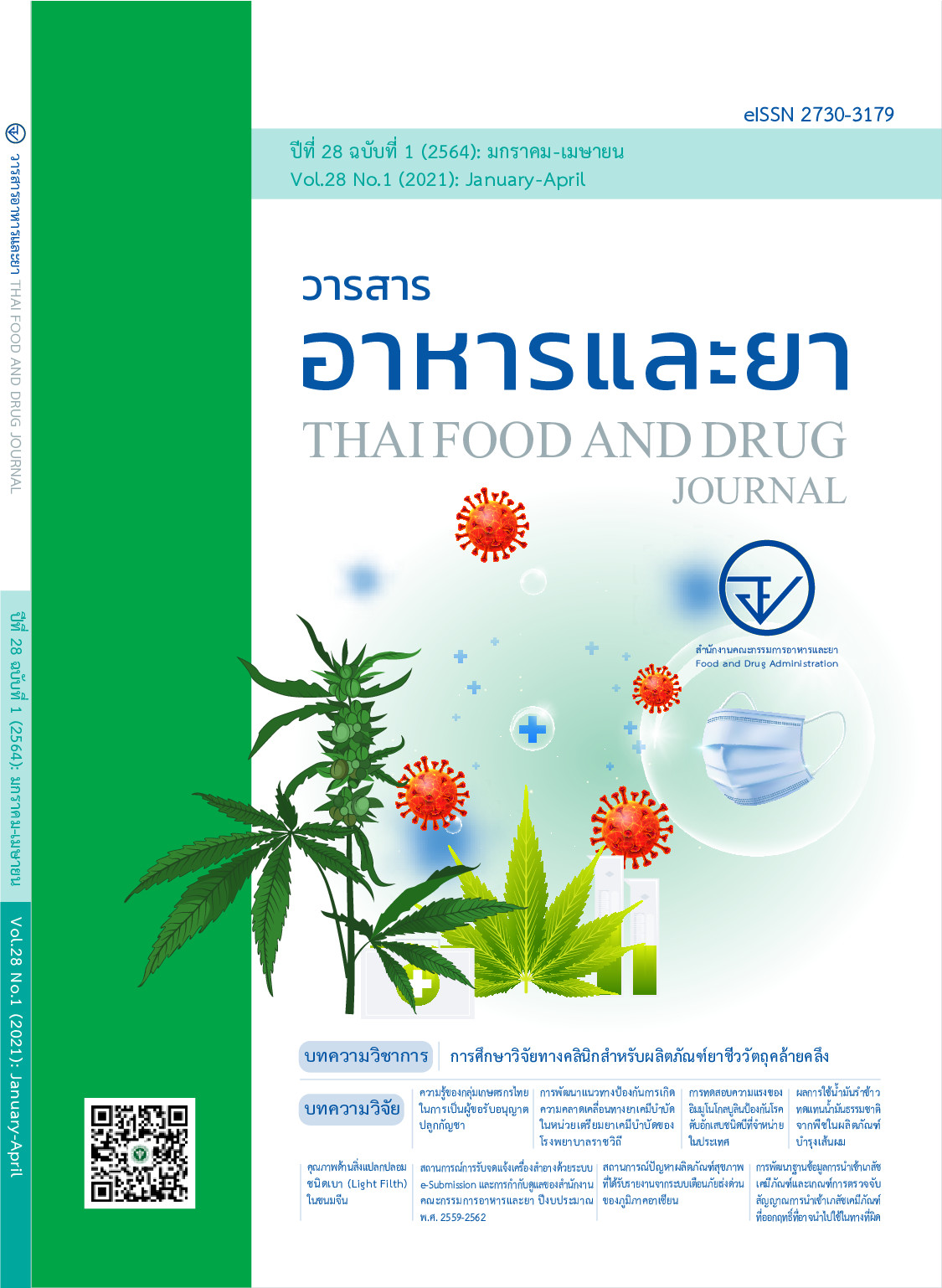สถานการณ์ปัญหาผลิตภัณฑ์สุขภาพที่ได้รับรายงานจากระบบเตือนภัยเร่งด่วนของภูมิภาคอาเซียน
Main Article Content
บทคัดย่อ
ความสำคัญ: กองด่านอาหารและยา ได้รับรายงานข้อมูลปัญหาผลิตภัณฑ์สุขภาพผ่านระบบเตือนภัยเร่งด่วนของภูมิภาคอาเซียน (ASEAN Post Marketing Alert System: PMAS) โดยใช้ประโยชน์ในการเฝ้าระวังและควบคุมความเสี่ยงในกรณีที่มีผลิตภัณฑ์ดังกล่าวนำเข้ามาจำหน่ายภายในประเทศไทย แต่ในช่วงที่ผ่านมายังไม่มีการรวบรวมรายงานและวิเคราะห์ข้อมูลอย่างเป็นระบบ
วัตถุประสงค์: เพื่อรวบรวมปัญหาด้านคุณภาพและความปลอดภัยของผลิตภัณฑ์สุขภาพที่มีการแลกเปลี่ยนผ่านระบบ PMAS
วิธีการวิจัย: ศึกษาจากรายงานผลิตภัณฑ์สุขภาพที่ได้รับแจ้งเตือนภัยจากระบบ PMAS ในปีงบประมาณ พ.ศ. 2560 ที่ได้รับรายงานจากประเทศสมาชิกอาเซียน ยกเว้นประเทศไทยที่กองด่านอาหารและยาได้รับจากศูนย์เฝ้าระวังความปลอดภัยด้านผลิตภัณฑ์สุขภาพ โดยครอบคลุมผลิตภัณฑ์เครื่องสำอาง ผลิตภัณฑ์เสริมอาหาร ยาแผนปัจจุบันและยาแผนโบราณ วิเคราะห์ข้อมูลด้วยสถิติเชิงพรรณนา
ผลการศึกษา: พบว่า กองด่านอาหารและยาได้รับรายงานผ่านระบบ PMAS 35 รายงาน ซึ่งมีผลิตภัณฑ์สุขภาพที่ได้รับแจ้งเตือน 291 รายการ ส่วนใหญ่เป็นปัญหาของเครื่องสำอาง ร้อยละ 67.4 โดยปัญหาที่พบในเครื่องสำอางคือ ปัญหาด้านความปลอดภัย พบสารห้ามใช้ในผลิตภัณฑ์บำรุงผิว เช่น สารปรอท ร้อยละ 36.5 สารไฮโดรควิโนนและอนุพันธ์ของกรดวิตามินเอ ร้อยละ 13.1 สารกันเสียที่ใช้ในเครื่องสำอางที่ใช้ส่วนใหญ่เป็น isobutyl paraben และ isopropyl paraben ยาแผนปัจจุบันพบปัญหาด้านคุณภาพมากที่สุด สาเหตุส่วนใหญ่เกิดจากกระบวนการผลิตยาไม่เป็นไปตามหลักเกณฑ์วิธีการที่ดีในการผลิตยาแผนปัจจุบัน ร้อยละ 78.0 ค่าการละลายไม่เป็นไปตามที่กำหนดร้อยละ 8.0 และค่าการละลาย/ค่าการแตกตัว และปริมาณตัวยาสำคัญไม่เป็นไปตามที่กำหนด ร้อยละ 4.0 ในขณะที่ยาแผนโบราณและผลิตภัณฑ์เสริมอาหารส่วนใหญ่ มีปัญหาด้านการปลอมปนสารที่มีฤทธิ์ทางยา ซึ่งสารที่มีฤทธิ์ทางยาที่พบปลอมปนมากที่สุด 3 อันดับแรก คือ sibutramine ร้อยละ 22.2 dexamethasone ร้อยละ 18.5 และ sildenafil ร้อยละ 11.1
สรุป: ข้อมูลรายงานจากระบบ PMAS สามารถนำไปใช้เป็นแนวทางในการพัฒนาระบบตรวจสอบและเฝ้าระวังผลิตภัณฑ์สุขภาพของกองด่านอาหารและยารวมถึงหน่วยงานที่มีหน้าที่ในการควบคุม กำกับดูแลผลิตภัณฑ์สุขภาพให้มีประสิทธิภาพมากขึ้น เพื่อคุ้มครองผู้บริโภคให้ได้รับความปลอดภัยจากการใช้ผลิตภัณฑ์สุขภาพ
Article Details

อนุญาตภายใต้เงื่อนไข Creative Commons Attribution-NonCommercial-NoDerivatives 4.0 International License.
เอกสารอ้างอิง
สำนักงานคณะกรรมการอาหารและยา. แนวทางดำเนินงานระบบเตือนภัยเร่งด่วนระหว่างประเทศในภูมิภาคอาเซียนของผลิตภัณฑ์สุขภาพภายหลังออกสู่ท้องตลาด. นนทบุรี: 2006.
ปฐม สวรรค์ปัญญาเลิศ, วิมล สุวรรณเกษาวงษ์. ระบบเฝ้าระวังความปลอดภัยด้านผลิตภัณฑ์สุขภาพประเทศไทย. เล่ม 1. นนทบุรี: สำนักงานพระพุทธศาสนาแห่งชาติ; 2559.
ศูนย์เฝ้าระวังความปลอดภัยด้านผลิตภัณฑ์สุขภาพ. ผลงานประจำปีงบประมาณ พ.ศ. 2557 [อินเทอร์เน็ต]. นนทบุรี: สำนักงานคณะกรรมการอาหารและยา; 2558 [เข้าถึงเมื่อ 10 พ.ค. 2563]. เข้าถึงได้จาก: http://thaihpvc.fda.moph.go.th/thaihvc/Public/News/uploads/hpvc_3_23_0_100560.pdf
ศูนย์เฝ้าระวังความปลอดภัยด้านผลิตภัณฑ์สุขภาพ. ผลงานประจำปีงบประมาณ พ.ศ. 2558 [อินเทอร์เน็ต]. นนทบุรี: สำนักงานคณะกรรมการอาหารและยา; 2559 [เข้าถึงเมื่อ 10 พ.ค. 2563]. เข้าถึงได้จาก: http://thaihpvc.fda.moph.go.th/thaihvc/Public/News/uploads/hpvc_3_23_0_100561.pdf
ศูนย์เฝ้าระวังความปลอดภัยด้านผลิตภัณฑ์สุขภาพ. ผลงานประจำปีงบประมาณ พ.ศ. 2559 [อินเทอร์เน็ต]. นนทบุรี: สำนักงานคณะกรรมการอาหารและยา; 2559 [เข้าถึงเมื่อ 10 พ.ค. 2563]. เข้าถึงได้จาก: http://thaihpvc.fda.moph.go.th/thaihvc/Public/News/uploads/hpvc_3_23_0_100670.pdf
กระทรวงสาธารณสุข. ประกาศกระทรวงสาธารณสุข เรื่อง กําหนดชื่อ ปริมาณ และเงื่อนไขของวัตถุที่อาจใช้เป็นส่วนผสมในการผลิตเครื่องสําอาง พ.ศ. 2561. ราชกิจจานุเบกษา เล่ม 135, ตอนพิเศษ 132ง (ลงวันที่ 8 มิถุนายน 2561).
กระทรวงสาธารณสุข. ประกาศกระทรวงสาธารณสุข เรื่อง กำหนดวัตถุกันเสียที่อาจใช้เป็นส่วนผสมในการผลิตเครื่องสำอาง พ.ศ. 2561. ราชกิจจานุเบกษา เล่ม 135, ตอนพิเศษ 263ง (ลงวันที่ 19 ตุลาคม 2561).
หรรษา ไชยวานิช, จรรยา มีศรี, สุดธิดา หมีทอง, นวพร อนันตสินกุล. การทดสอบความชํานาญของประเทศสมาชิกอาเซียน ในการตรวจวิเคราะห์ไฮโดรควิโนนในเครื่องสําอางครีมทาหน้า ปี พ.ศ. 2554. วารสารวิชาการสาธารณสุข. 2557;23(1):121-9.
นันทนา กลิ่นสุนทร, ชมพูนุท นุตสถาปนา, ตวงพร เข็มทอง, ปริชญา มาประดิษฐ์. สารห้ามใช้ในผลิตภัณฑ์เครื่องสำอางทาสิว ทาฝ้า ทำให้หน้าขาว ในเขตภาคกลางตอนล่าง ระหว่างปี 2553-2556. วารสารอาหารและยา. 2556;20(3):28-36.
สำนักเครื่องสำอางและวัตถุอันตราย กรมวิทยาศาสตร์การแพทย์. รายงานประจำปี 2561 annual reportสำนักเครื่องสำอางและวัตถุอันตราย: โครงการประเมินคุณภาพความเสี่ยงต่อการสัมผัสสารรบกวนการทำงานของระบบต่อมไร้ท่อ (Endocrine disruptors) กลุ่มสารกันเสียชนิดพาราเบนที่ใช้ในผลิตภัณฑ์เครื่องสำอางปี 2560-2561 [อินเทอร์เน็ต]. นนทบุรี: สำนักเครื่องสำอางและวัตถุอันตราย กรมวิทยาศาสตร์การแพทย์; 2562 [เข้าถึงเมื่อ 10 พ.ค. 2563]. เข้าถึงได้จาก:http://www.dmsc.moph.go.th/cosmetics/userfiles/files/ar(1).pdf
จันทนา พัฒนเภสัช, สมศักดิ์ สุนทรพาณิชย์, สุรัชนี เศวตศิลา, โสมขจี หงษ์ทอง. คุณภาพยาในประเทศไทย: ข้อมูล 15 ปีจากโครงการประกันคุณภาพยา กรมวิทยาศาสตร์แพทย์ กระทรวงสาธารณสุข. วารสารวิจัยระบบสาธารณสุข. 2561;12:124-36.
ชุติมา จามีกรกุล. ระบบเตือนภัยเร่งด่วนของผลิตภัณฑ์สุขภาพภายหลังออกสู่ตลาด ระหว่างประเทศ สมาชิกอาเซียน; ข่าวสารด้านยาและผลิตภัณฑ์สุขภาพ. กรุงเทพฯ: ชุมนุมสหกรณ์การเกษตรแห่งประเทศไทย; 2553;13(3):92-6.


